This is part three in a series of posts about how I introduce the routines of Math Workshop over the course of three weeks. If you would like to start by reading about the first two weeks of Math Workshop, visit the links below.
BACKGROUND ABOUT THE THIRD WEEK OF MATH WORKSHOP
My goals for the third week of Math Workshop are focused around further solidifying the routines and expectations that we’ve established during the first two weeks, and to introduce a final few routines and tools that boost students’ ability to be self-directed learners so workshop can run at full efficiency. These goals include:
- Review and solidify expectations for warm-up, mini lessons, at your seat rotation, and hands on rotation.
- Introduce the technology rotation.
- Introduce our digital Math Workshop rotation board.
- Emphasize the thoughtful equity built into our weekly Math Workshop schedule.
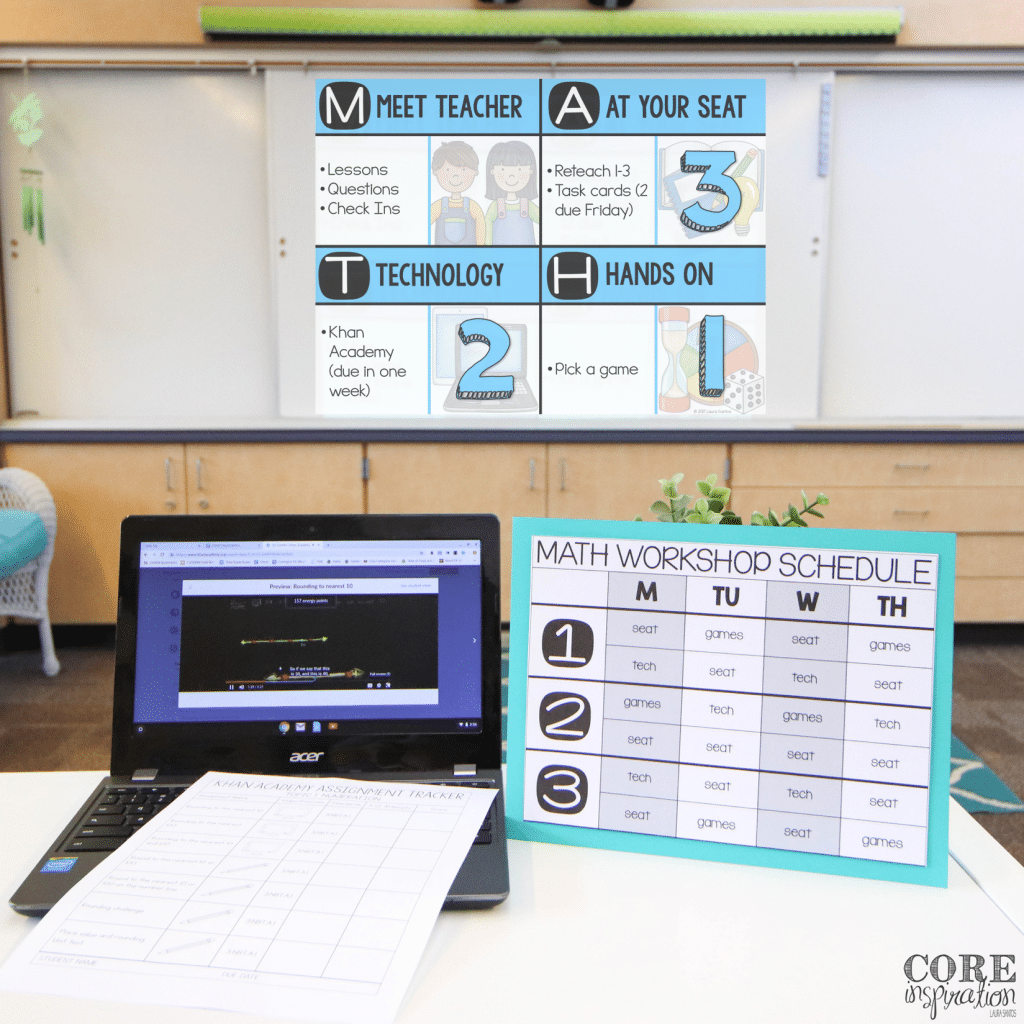
To accomplish these goals, I follow the plans outlined below.
Day 9: More Independent Routines and the Technology Rotation
On our ninth day of workshop, we are one step away from the workshop structure feeling fully-functional as students learn about their final independent rotation: technology. Reserving the rollout of the technology rotation has two purposes. First, it gives me time to establish routines and expectations for technology use during the first weeks of school outside of the Math Workshop block. At this point in the year, students have been trained on technology expectations, have earned their Chromebook license, and have signed their Chromebook contract. The second reason I save the technology rotation for last is because it’s the easiest to introduce.

Math Group Numbers
- Set a math group number on each desk. Before school, I place a math group number on the corner of each students’ desk. At this point, I’ve had some time to get to know students’ work habits as well as their math strengths and needs. I create groups mainly based on place value proficiency, which will be required for the current unit. Students who need heavy support are part of group 1, students who need some support are part of group 2, and students who are independent are part of group 3.
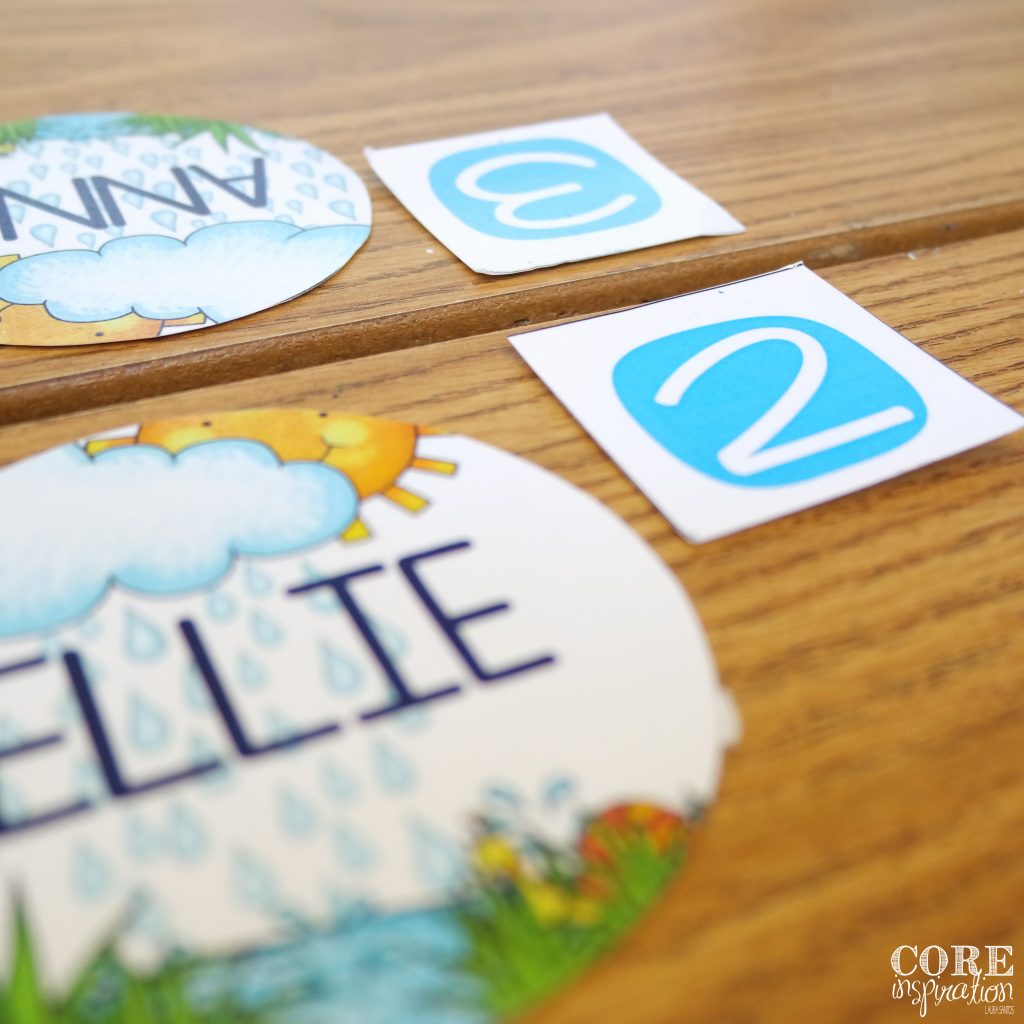
- Inform students about the new numbers. Before students head into the classroom in the morning, I tell them about the meaning of the number on the corner of their desk so they don’t get to distracted by the numbers. Giving them this heads up helps students head into the room responsibly so they can immediately focus on their warm up routine.
Warm-Up Routine
- Begin the warm up without an expectation review. I display the warm up checklist, and students work through the checklist with independence. I use plenty of positive reinforcement for the specific behaviors and routines my students recall.
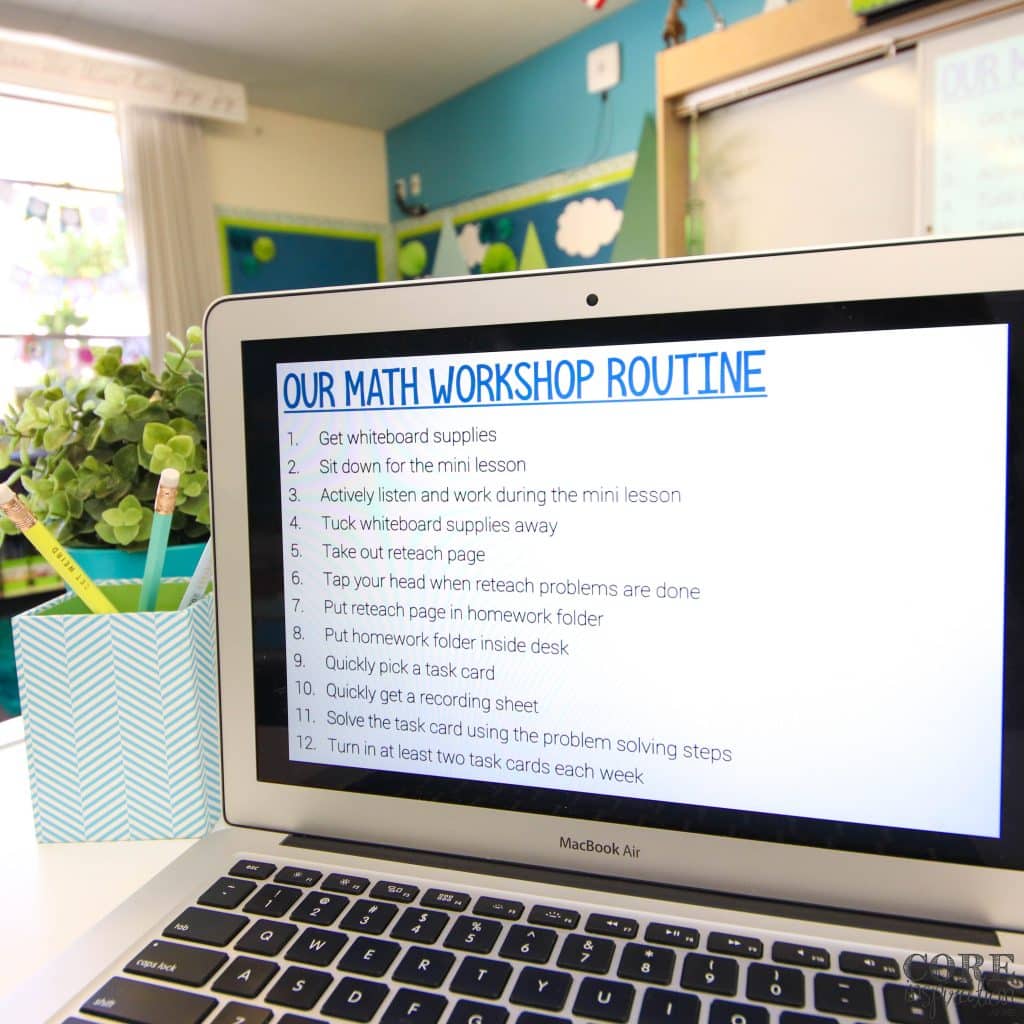
Digital Rotation Board
- Introduce the digital Math Workshop rotation board. Before the mini lesson begins, I introduce the most helpful tool we use each day during Math Workshop. The digital Math Workshop rotation board shows students what their daily Math Workshop rotation assignments are, keeps track of time during each rotation, provides a transition countdown to expedite student transition time, and uses chimes and visuals to signal to students when it is time to rotate to and begin the next activity. This board does all the hard work for me so I can focus on getting prepped for small groups, and help students who may need support with transitions. The students love the high level of independence they are able to achieve with the rotation board as their guide.
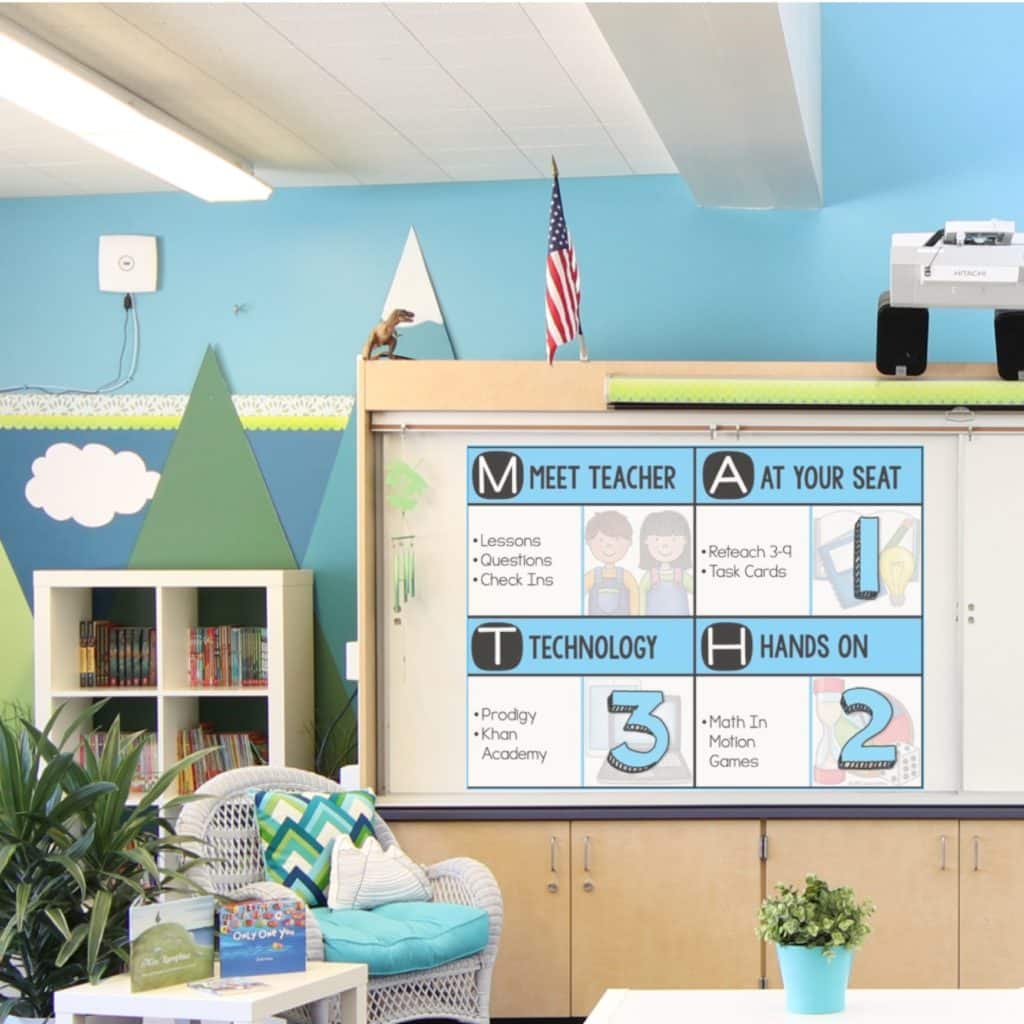
- Have students identify their group. I begin by having students look at the number on their desk. Ones raise their hands, then twos, then threes, and so-on until they’ve had a bit of practice with referencing the small number on the corner of their desk.
- Show students their group assignments. I then demonstrate how to use the number on the desk to identify which rotation each student will be working on first. Students look for their number on the right side of the rotation board, and read which M.A.T.H. rotation they should be working on.

- Point out the countdown timer. Students are immediately awed by the countdown timer that displays next to their rotation assignments. As I talk them through the rotation assignments, they hear a tick-tock sound when the countdown timer reaches one minute. This is a gentle reminder that a minute has passed, and they only have a minute left to get settled into their rotation activity.
- Introduce the rotation assignment slide. Once the transition timer reaches zero, a chime sounds and the details of each rotation are displayed next to the number of the group working on each rotation. I share that this slide will be on display for the duration of the first rotation, and it will silently keep track of time for us. When twenty minutes has passed, the rotation board will automatically chime, another countdown timer will begin, and they will be expected to calmly move to their second workshop rotation before the countdown reaches zero.

- Ask for interest. After explaining the digital rotation board and giving students a little sneak peak at it’s capabilities, I ask if they’d be interested in using this tool to guide us during workshop. Of course, there is always a resounding, “YES!” Their excitement is really quite adorable.
Mini Lesson
- Teach the mini lesson. I continued to monitor and compliment their responsible whiteboard use. After the lesson, I display the digital rotation board and watch the magic of the first transition with the support of this new tool. It’s always a thing of beauty.
Rotating with Tools for Support
- Observe carefully as students work at different rotations for the duration of a rotation block. Since this is the first day students are working on different rotation activities immediately following the mini lesson, I keep a close eye on their independence, ability to navigate and utilize their tools, and the collaborate with teeny tiny voices. Plenty of verbal feedback is provided.
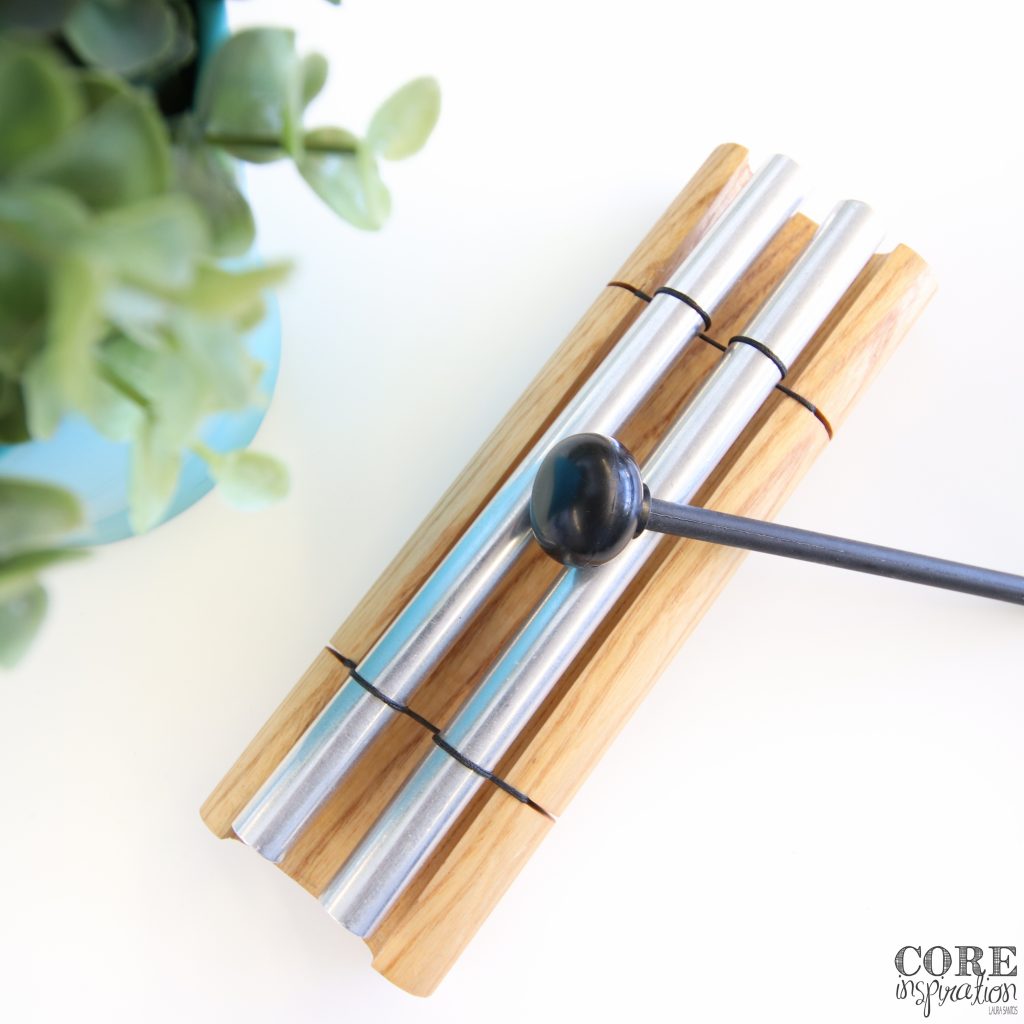
- Introduce the double chime. After students have worked through their first rotation, transitioned using our digital rotation board, and settled into their second transition, they hear a noise they’ve never heard. A double chime. Since the noise is a novelty, they immediately freeze and scan the room for the source. Their curiosity makes this the perfect opportunity to introduce how this tool will be used to further support respect and care for one another during workshop.
- The double chime will only ring if their noise level is too high.
- If the chime rings once, it is a warning to adjust to teeny tiny voices and continue working.
- If the noise level increase again, the chime will ring a second time, which means everyone must silently return to their seat and work independently for the remainder of that rotation. This aligns with our Responsive Classroom work around the logical consequence of losing a privilege if you can’t meet the agreed-upon expectations.
- When a new rotation begins, the chime count resets.
Khan Academy
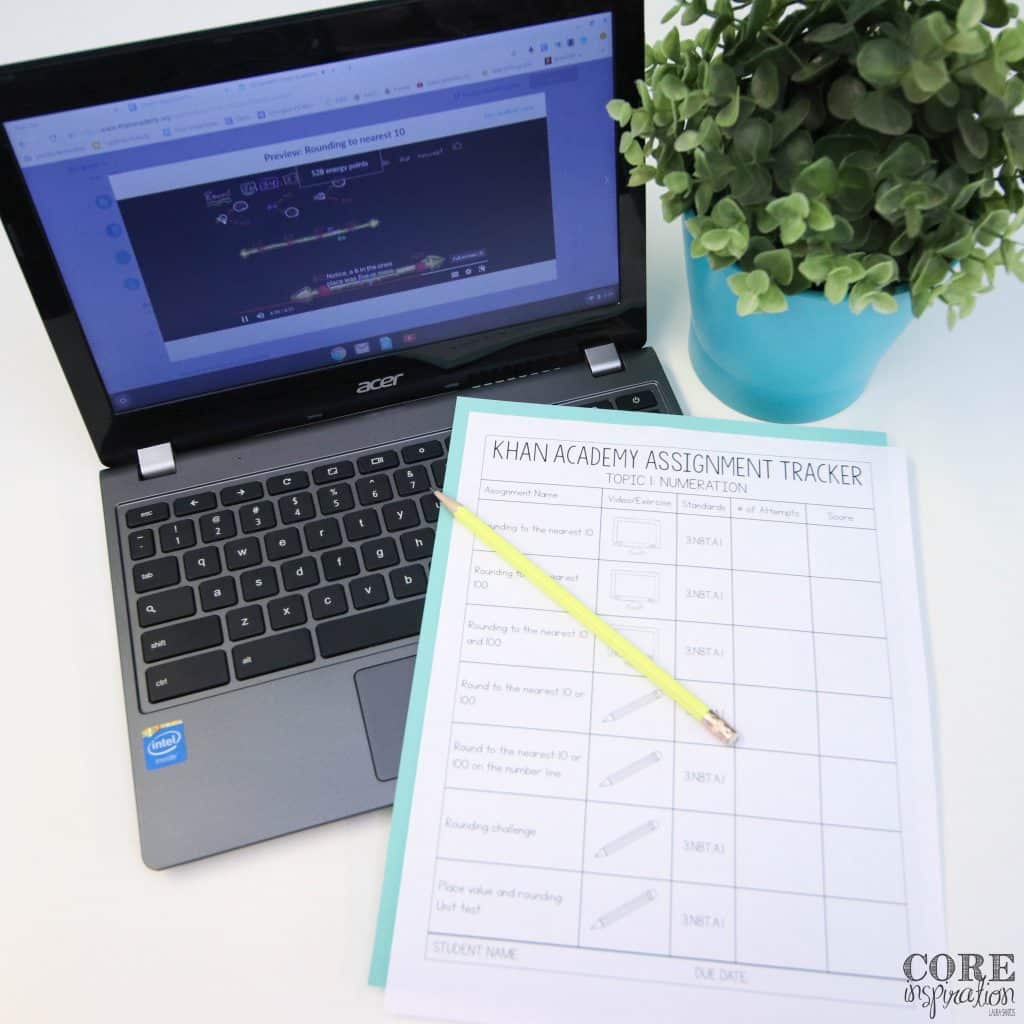
- Introduce Khan Academy as a tech activity. Later that day (in place of Math Game Monday), I introduce the technology rotation activity we’ll be using throughout the year: Khan Academy. I begin by handing out the tracking sheets where students will log their work. We set a due date for our first batch of assignments which is aligned with our current math unit.
- Students learn how to log into their accounts and join our class. The class code and the assignments that are listed on the tracking sheet are all set up by me before school that day.
- Students complete their first assignment. When the first student finishes, I use his/her sheet to model how to mark complete assignments on the tracker before moving on to the next assignment. This process continues for about fifteen minutes until everyone has tacked a couple assignments.
- Store the trackers. Students learned how to store their Khan Academy tracker in the back pocket of their Number of the Day Binder.
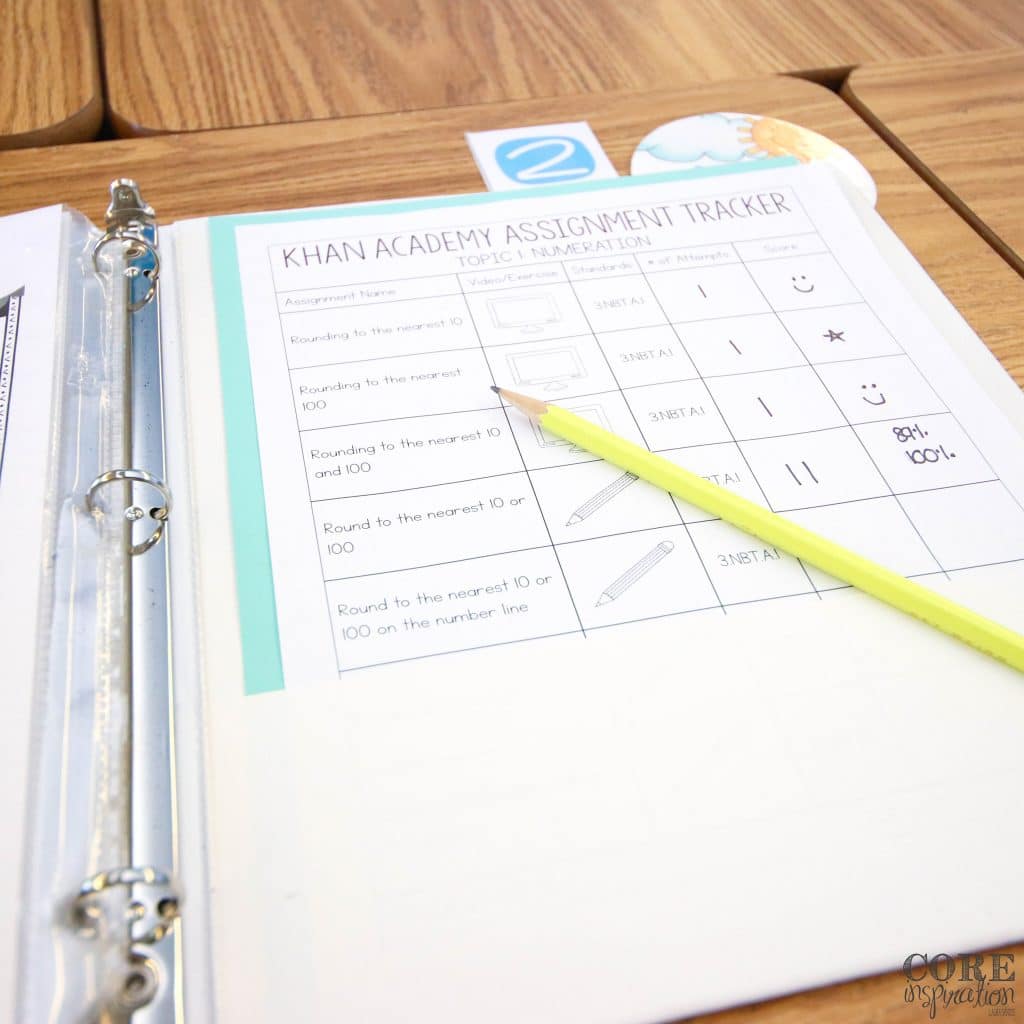
I close day 9 by letting students know technology will be a rotation option starting tomorrow during workshop.
Days 10-12: It All Comes Together
By the tenth day of workshop, students have learned about all three independent rotations, which allow me to confidently pull groups knowing they are focused and independent at their seats. For the last three days of our roll-out, I continue to support them as they solidify these routines and get a feel for the flow of a fully-functional math workshop environment.
Rotation Equity
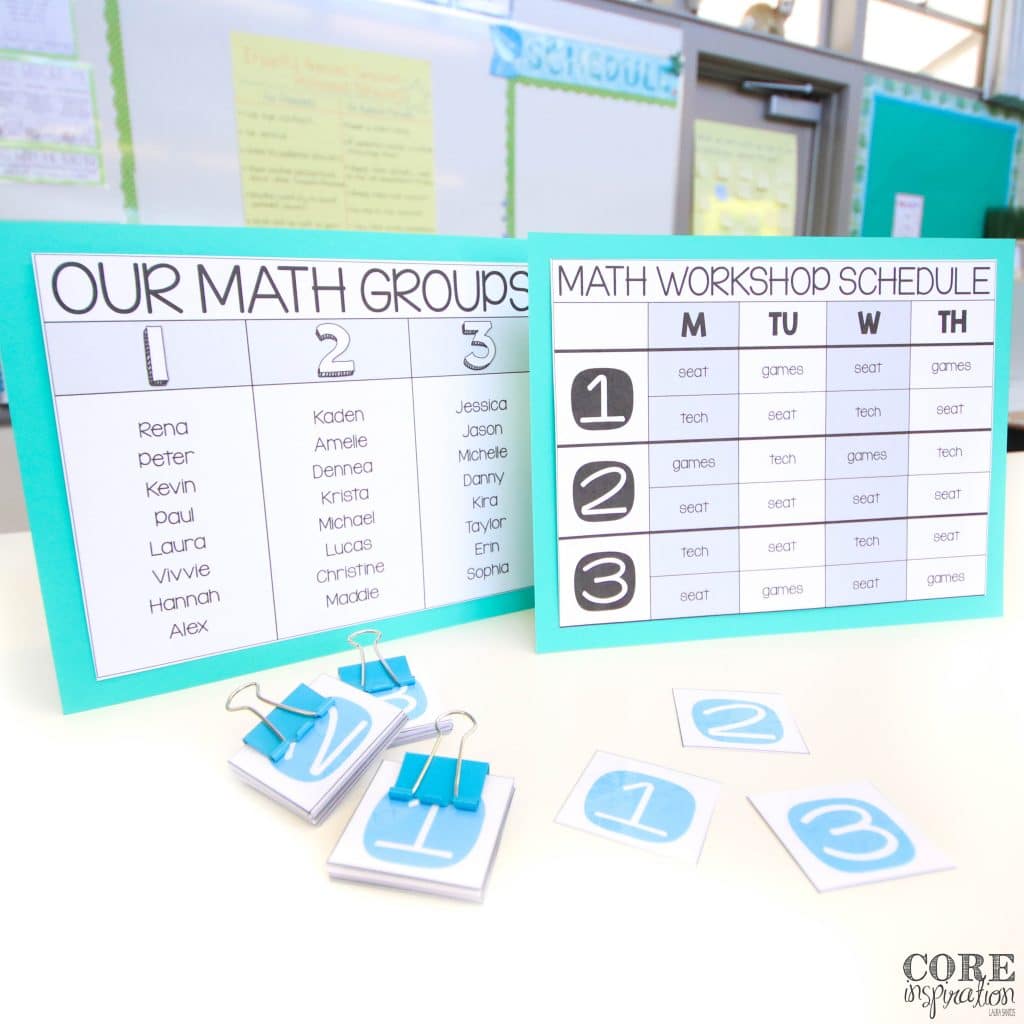
- Show students the weekly Math Workshop schedule you have designed. Now that all the independent rotations have been rolled out, there are always a handful of students who feel unsure about whether it’s fair when their friend is working at their favorite rotation, and they have to wait until tomorrow to enjoy that rotation. To put their worries to rest, we spend time on the tenth day of workshop looking closely at the weekly schedule that will be used consistently throughout the year. This schedule shows students that everyone works at their seat every day, and rotates through the technology and hands of rotations the same number of times each week.
Mini Lesson
Practice, Practice, Practice
- Teach the mini lesson. I continue to monitor and compliment their responsible whiteboard use. After the lesson, I display the digital rotation board and watch the magic of the first transition with the support of our favorite tool.
- As students practice all the routines you’ve introduce over the past two weeks, give feedback. At this point, I simply let the routines of workshop flow. If any adjustments need to be made, we discuss them during transition time, or at the end of workshop that day. Students receive verbal feedback about their transitions, focus during rotations, collaboration using teeny tiny voices, use of math triads, and self-directed learning skills.
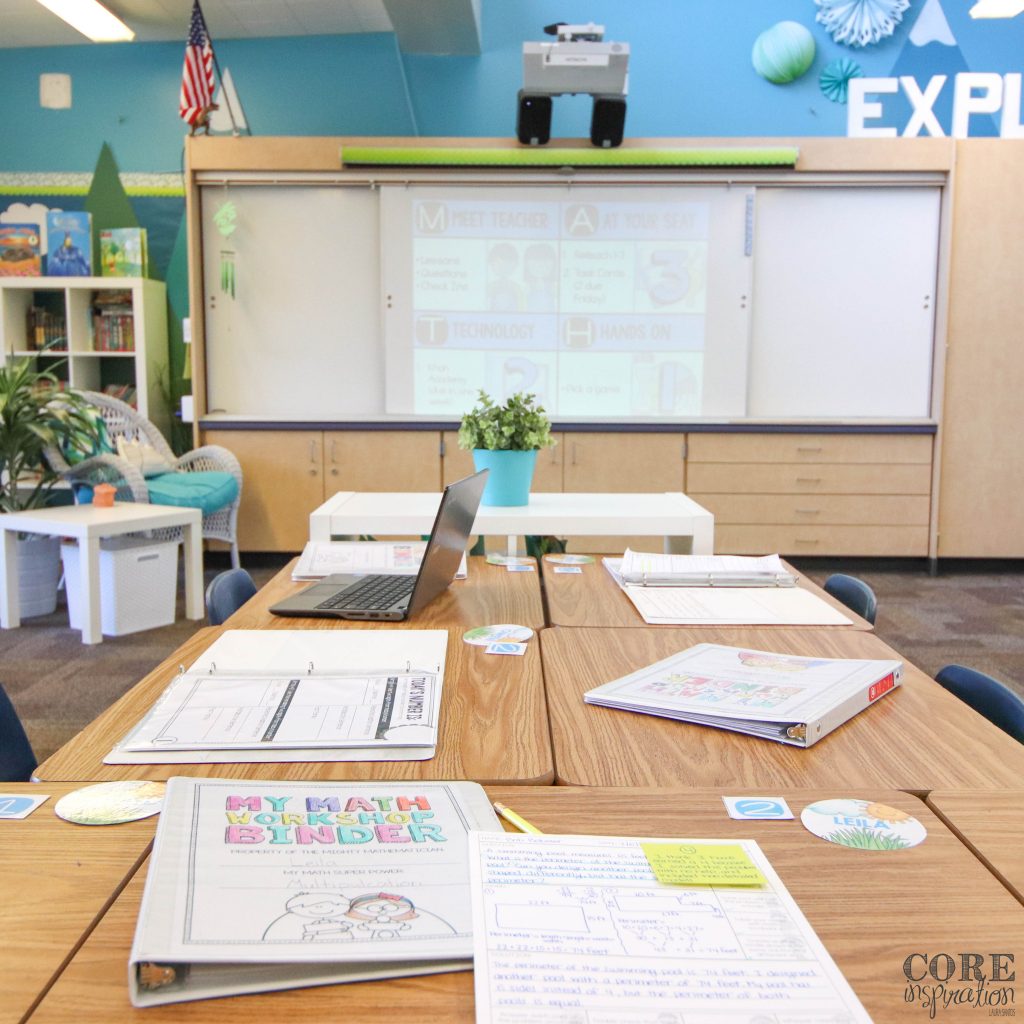
For the final three days of the third week, I continue the practice process explained above.
Reflecting on Week 3
Seeing all thoughtful introduction of routines and expectations lead to a very clam, smooth, and productive block of learning is such a reward. I personally hold off on pulling small groups until the first day of the fourth week of workshop because I find it important to solidify the incredible number of self-directed learning routines these students have learned about Math Workshop over the past three weeks.
When I sit down at the small group table for the first time, I want to be highly confident that students who are not in my small groups are buzzing away efficiently as they practice math skills. That small group time is so critical, and I want to be fully present with the students sitting across the table from me knowing that the rest of the class isn’t missing a beat.
How did the roll-out of Math Workshop work in your classroom? Any lingering roll-out questions? I’d love to hear from you in the comments below.
INTERESTED IN LEARNING MORE?
For more details about Math Workshop, check out my other posts about this instructional approach.
HOW TO INTRODUCE MATH WORKSHOP IN YOUR CLASSROOM:
DETAILS ABOUT M.A.T.H. ROTATIONS:
- Overview: Differentiate Instruction with Math Workshop
- Warm Up: Number of the Day Binder
- Mini Lesson: 3 Approaches To Formatting Lessons for Math Workshop
- Meet with the Teacher: How To Organize Small Groups for Math Workshop
- Meet with the Teacher: 5 Steps To Efficient Data Tracking
- At Your Seat: Top 5 Ideas for Math Workshop At Your Seat
- At Your Seat: Boost Problem Solving Skills
- Hands On: Tips for Making Math Games A Success
MATH WORKSHOP CLASSROOM MANAGEMENT TIPS:
- How To Boost Student Independence With Math Triads
- Incorporating Project Based Learning Into Math Workshop
- How To Make Transitions Efficient During Math Workshop
READY TO GIVE MATH WORKSHOP A TRY?
If you want to give Math Workshop a test drive in your own classroom, grab your Math Workshop Starter Kit, and feel free to share any questions you have about implementation in the comments below.



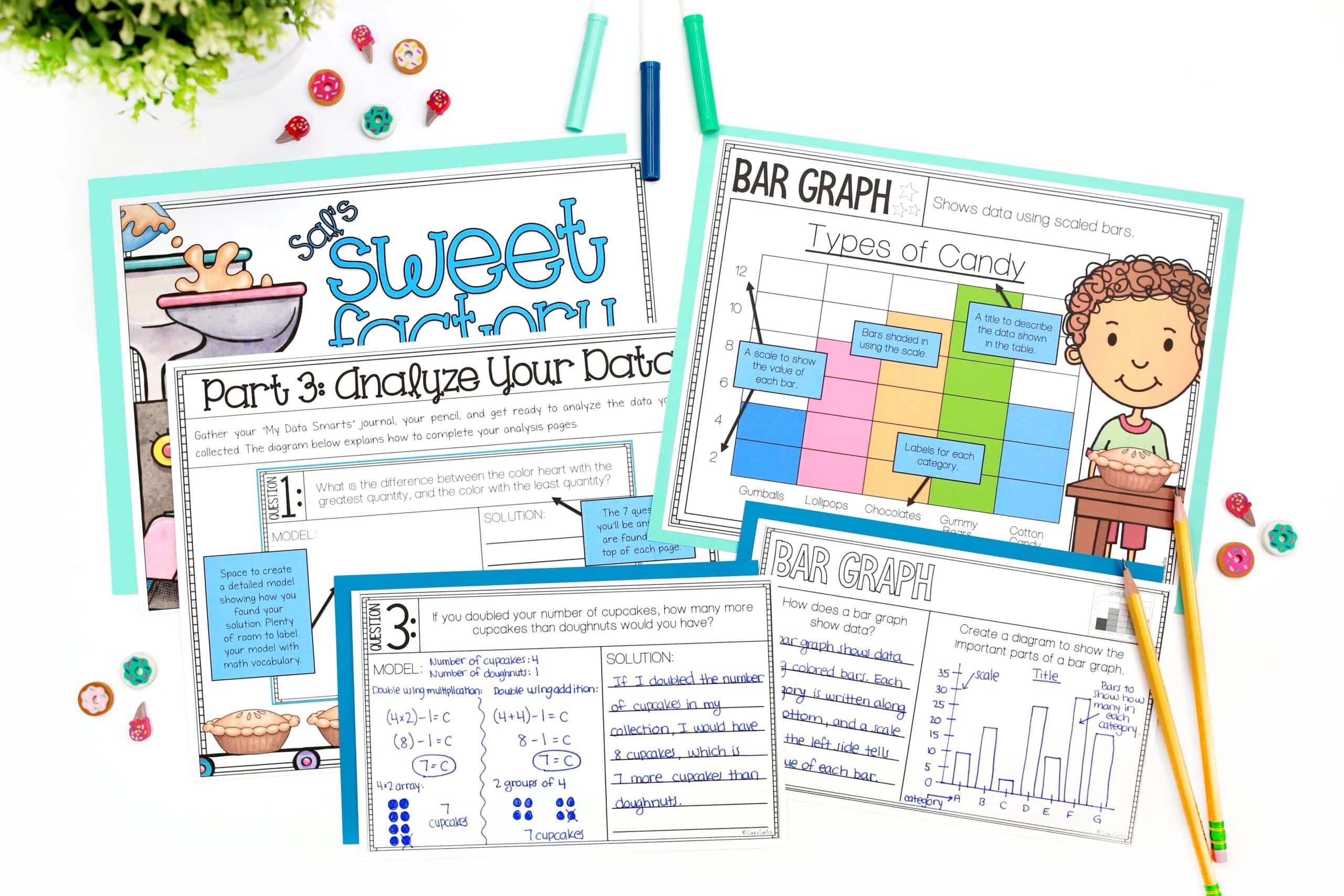
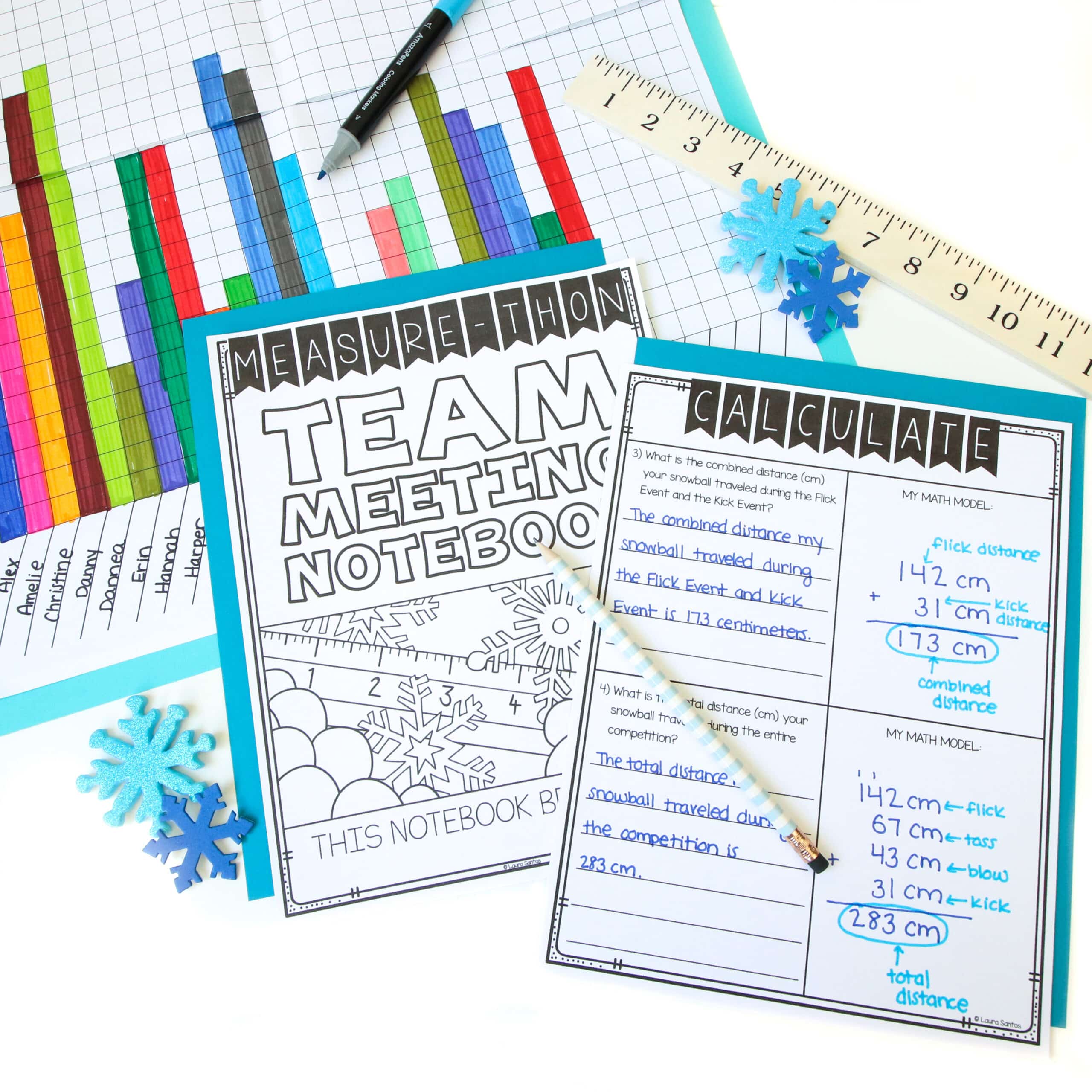

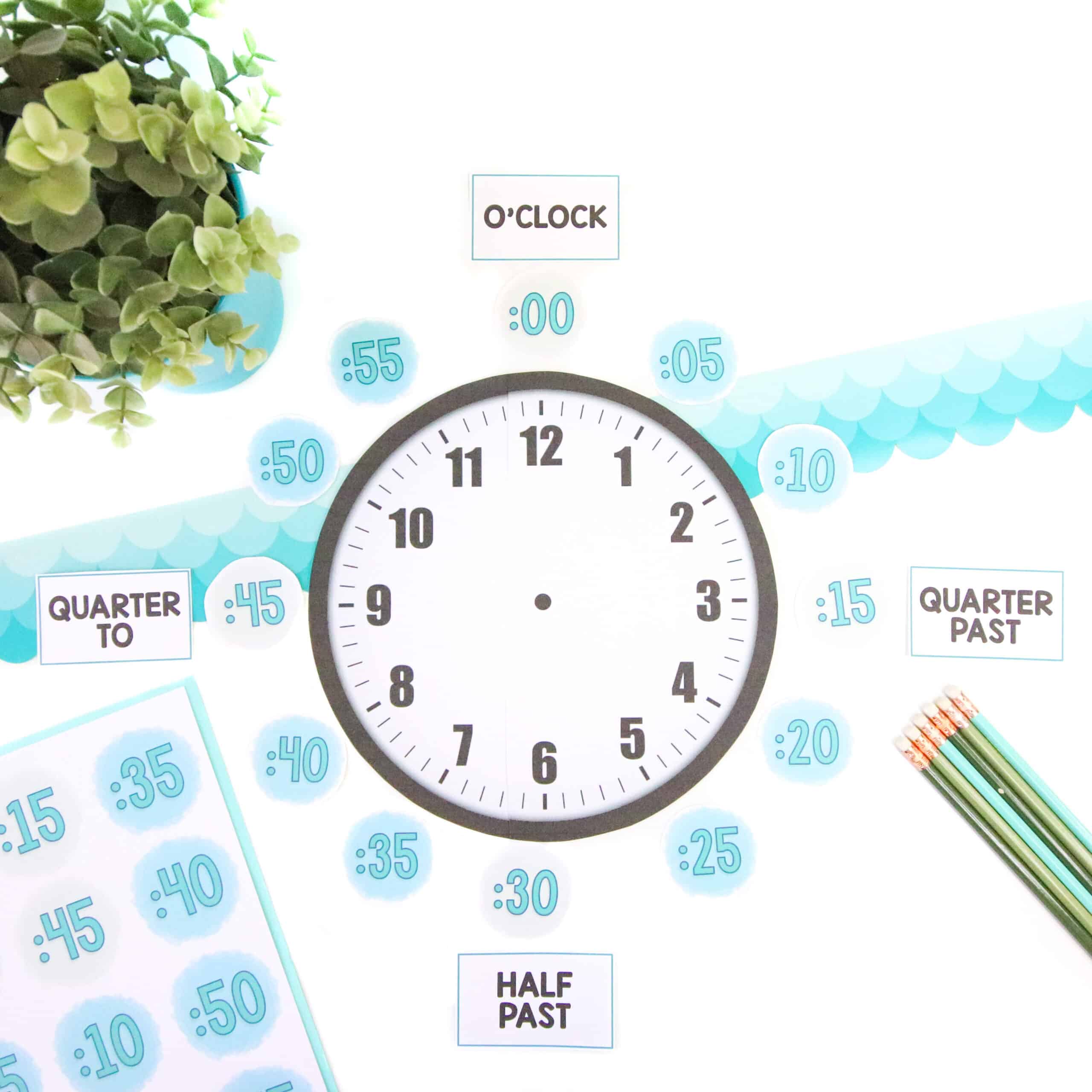
14 Responses
Hello,
Do you have a copy of the Khan Academy Assignment tracker to purchase.
Thank you,
Tracy
Hi Tracy,
Thank you for reaching out. I don’t currently have the tracker available for sale.
Warmly,
Laura
Hi Laura,
I was watching Fantastically Fourth’s instagram story about math workshop which referred me to your blog and I am blown away by your in depth walk through of the workshop roll out. I am a second year 5th grade teacher and am very excited to implement this in my classroom.
I have a couple questions about the grouping.
I understand the process of the pre assessment, breaking it in thirds, and choosing a student from each to make the triad. Now to clarify: you place multiple triads in each of the 3 groups, right? Do you post those triads anywhere? or just the 3 groups? And if you do post the triads, do you ask the students to only collaborate with their triad when they are at each center, or do you encourage them to ask anyone from the larger group?
Hi Jen,
Thank you for the kind comment. 🙂 So happy to hear the posts about math workshop are helpful. Hopefully these clarifications are helpful.
When it comes to designing triads, students in a triad do not all need to be in the same group. Students can ask their triad members for support even if they are working on other activities (for example, one triad member woking on a task card may need support from their other triad member who is playing a game). They are also welcome to ask people outside their triad for support if they feel that would be helpful (for example, sometimes two students working on task cards who are not part of a triad work together, which is also great). The triads are really there to make sure everyone knows they have someone they can turn to for support if they get stuck, and are especially helpful for students who need more structure with collaboration.
I do post the triads in the classroom next to our weekly schedule. If you’d like to read more, you can check out this post. 🙂
Warmly,
Laura
Hi Laura! Thank you so much for the response. That was very helpful!
Hi Laura,
I am so appreciative of you taking the time to explain your math workshop roll out in such detail. I have been following along and we are about to start week 3 next week. I noticed that you start having students go to all 4 rotations but you still do not pull groups since you are praising and complimenting. What does your Meet the Teacher group do during week 3? Thank you so much! So far I am blown away with how well we are doing with routines and I know it is in part to your amazing resources and guidance.
Hi Caitlin, I love hearing about your success with rolling out workshop…so exciting! During week 3, I still don’t have a group specifically assigned to come meet with me. I continue to observe and move around the room for conferring as students work at all the other rotations. 🙂
Warmly,
Laura
Hi Laura,
I love your website and am constantly learning more every time I return to read more! Just learned about the Khan Academy Tracker! Do you plan on making your Khan Academy Tracker for sale in the future?
Thank you!
Marlese
Hi there!
I was wondering what the reteach pages are. Your workshop model is great, and I hope to try it this coming school year!
Kaleigh
Thank you Kaleigh. Our reteach pages are worksheets that are included in our district-adopted curriculum EnVision Common Core Math. They are worksheets with 5-10 questions that allow students to practice the skills taught during the mini lesson.
Hi Laura!
I really enjoy your blog and I have been reading your posts for over a year now! I loved reading this series about Math Workshop and I would love to implement some of these techniques in my math instruction some day (when we go back to a less distances style of teaching!).
I was wondering if you could do a post like this for writer’s workshop and reader’s workshop/instruction? I’m not sure if you follow that style at your school, but I was love some tips for writing instruction mostly. If you already have a post, then I apologize for missing it!
Thank you so much for all your guidance and encouragement!
Hi Hannah,
Thank you so much for the kind words! I’m glad the posts are helpful. We do use reading and writing workshops at our school, but my focus for blogging right now is on math and classroom management. 🙂
Warmly,
Laura
What do you do for Math Workshop on Fridays?
Hi Heather. We have too many specials on Fridays to complete math workshop so I only do the warm up portion of workshop on Friday.